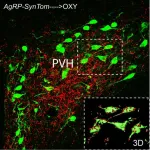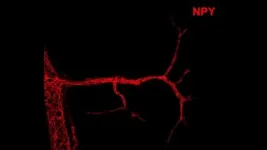(Press-News.org) Researchers from Durham University, Jagiellonian University (Poland) and the John Innes Centre have achieved a breakthrough in understanding DNA gyrase, a vital bacterial enzyme and key antibiotic target.
This enzyme, present in bacteria but absent in humans, plays a crucial role in supercoiling DNA, a necessary process for bacterial survival.
Using high-resolution cryo-electron microscopy the researchers reveal unprecedented detail of gyrase’s action on DNA, potentially opening doors for new antibiotic therapies against resistant bacteria.
The research is published in Proceedings of the National Academy of Sciences (PNAS).
DNA gyrase operates like a tiny molecular machine, carefully twisting and stabilising bacterial DNA. This twisting, known as supercoiling, is similar to winding an elastic band: as it twists, it coils tighter and tighter.
Unlike a band that would unwind if released, DNA gyrase stabilises DNA’s twisted form, making it functional for bacteria.
The enzyme wraps DNA in a ‘figure-of-eight’ loop, then precisely breaks and passes strands through each other, resealing them afterward. This is a delicate process—if the DNA remained broken, it would be lethal to the bacteria.
Antibiotics such as fluoroquinolones exploit this vulnerability by preventing the DNA resealing, which kills the bacterial cell. However, resistance to these antibiotics is growing, so a deeper understanding of how gyrase functions is urgently needed.
Using state-of-the-art cryo-electron microscopy, the team captured a snapshot of gyrase at work, revealing how it wraps DNA through outstretched protein arms to form the figure-of-eight shape.
This finding updates the conventional view of gyrase’s mechanism, which has been studied for decades. The images show the enzyme as a highly coordinated, multi-part system, with each piece moving in a precise sequence to achieve DNA supercoiling.
Reflecting on the study findings, co-author Professor Jonathan Heddle of Durham University said: “The results suggested the exact position and the order of the complex moving parts of the enzyme during when the supercoiling process occurs were not quite as we previously thought, and this could impact how we design new inhibitors.”
This discovery not only advances our knowledge of bacterial biology but also holds promise for new antibiotics designed to block gyrase in a more targeted way, bypassing existing resistance mechanisms.
With this high-resolution structure as a guide, researchers aim to take additional snapshots of the enzyme in various stages, building a molecular movie of how gyrase works.
This detailed approach could aid in the development of next-generation antibiotics that are more precise and effective in stopping bacterial infections.
END
Scientists uncover new mechanism in bacterial DNA enzyme opening pathways for antibiotic development
2024-11-25
ELSE PRESS RELEASES FROM THIS DATE:
New study reveals the explosive secret of the squirting cucumber
2024-11-25
UNDER EMBARGO UNTIL 20:00 GMT / 15:00 ET MONDAY 25 NOVEMBER 2024
New study reveals the explosive secret of the squirting cucumber
IMAGES AND VIDEO AVAILABLE – SEE NOTES SECTION BELOW
A team led by the University of Oxford has solved a mystery that has intrigued scientists for centuries: how does the squirting cucumber squirt? The findings, achieved through a combination of experiments, high-speed videography, image analysis, and advanced mathematical modelling, have been published today (25 November) in The Proceedings of the National Academy of Sciences (PNAS).
The squirting cucumber (Ecballium elaterium, from the Greek ‘ekballein,’ meaning to throw out) is named for ...
Vanderbilt authors find evidence that the hunger hormone leptin can direct neural development in a leptin receptor–independent manner
2024-11-25
Researchers from the Vanderbilt University School of Medicine Basic Sciences have uncovered the first example of activity-dependent development of hypothalamic neural circuitry. Although previous research has shown that the hormone leptin acts directly on hunger neurons through leptin receptors to promote the development of neural circuitry, results that will be published in PNAS on Nov. 25 indicate that certain neurons that do not express leptin receptors are nonetheless sensitive to its activity.
The research, led by the lab of Richard Simerly, Louise B. McGavock Professor and professor of molecular physiology ...
To design better water filters, MIT engineers look to manta rays
2024-11-25
Filter feeders are everywhere in the animal world, from tiny crustaceans and certain types of coral and krill, to various molluscs, barnacles, and even massive basking sharks and baleen whales. Now, MIT engineers have found that one filter feeder has evolved to sift food in ways that could improve the design of industrial water filters.
In a paper appearing this week in the Proceedings of the National Academy of Sciences, the team characterizes the filter-feeding mechanism of the mobula ray — a family of ...
Self-assembling proteins can be used for higher performance, more sustainable skincare products
2024-11-25
If you have a meticulous skincare routine, you know that personal skincare products (PSCPs) are a big business. The PSCP industry will reach $74.12 billion USD by 2027, with an annual growth rate of 8.64%. With such competition, companies are always looking to engineer themselves an edge, producing products that perform better without the downsides of current offerings.
In a new study published in ACS Applied Polymer Materials from the lab of Professor of Chemical and Biomolecular Engineering Jin Kim Montclare, researchers have created a novel protein-based gel as a potential ingredient in sustainable and high-performance PSCPs. This protein-based ...
Cannabis, maybe, for attention problems
2024-11-25
Cannabis — whether marijuana itself or various products containing cannabinoids and/or THC, the main psychoactive compound in weed – have been touted as panaceas for everything from anxiety and sleep problems to epilepsy and cancer pain.
Nursing researcher Jennie Ryan, PhD, at Thomas Jefferson University, studies the effects of cannabis on symptoms of attention deficit hyperactivity disorder (ADHD). Current medical guidelines for ADHD include medications such as Adderall and cognitive behavioral therapy. ...
Building a better path to recovery for OUD
2024-11-25
A new study led by Thomas Jefferson University researchers highlights critical healthcare gaps that hinder long-term recovery for people living with opioid use disorders (OUD) in Philadelphia.
The researchers conducted 13 focus groups with 70 participants accessing various types of OUD treatment. Participants reported several challenges, such as lengthy and restrictive assessment processes, inadequate operating hours and lack of sufficient withdrawal management. Participants also reported broader socio-economic needs, such as housing and income support, as barriers to their recovery.
Meghan Reed, PhD, MPH, senior ...
How climate change threatens this iconic Florida bird
2024-11-25
ITHACA, N.Y. – Because of warmer winters, Florida scrub-jays are now nesting one week earlier than they did in 1981. But these early birds are not always getting the worm.
A new analysis of data from a long-term study, published in Ornithological Advances, finds that warmer winters driven by climate change reduced the number of offspring raised annually by the federally threatened Florida scrub-jay by 25% since 1981.
Warmer temperatures, the scientists hypothesize, make jay nests susceptible to predation by snakes for a longer period of the Florida ...
Study reveals new factor involved in controlling calorie expenditure
2024-11-25
An international team of researchers has discovered a new component of the peripheral nervous system that acts by increasing energy metabolism in the body. The finding paves the way for the development of simpler and cheaper drugs to control obesity and weight gain, regardless of the amount of food ingested.
In an article published in the journal Nature, researchers from the University of Oxford in the United Kingdom and the Obesity and Comorbidities Research Center (OCRC) – funded by FAPESP and based at the State University of Campinas (UNICAMP) in Brazil – describe where and how this component ...
Managing forests with smart technologies
2024-11-25
Deforestation has remained a significant issue globally, with primary forests contributing to 16 per cent of the total tree cover loss in the last two decades, driven by climate change and intensive human activity. This threatens natural resources, biodiversity, and people’s quality of life. To protect forests, Lithuanian scientists, in collaboration with Swedish experts, have developed Forest 4.0, an intelligent forest data processing model integrating blockchain, Internet of Things (IoT), and Artificial Intelligence (AI) technologies. The system ...
Clinical trial finds that adding the chemotherapy pill temozolomide to radiation therapy improves survival in adult patients with a slow-growing type of brain tumor
2024-11-25
Both radiation and temozolomide, a generic chemotherapy treatment in pill form, have meaningful single-modality anti-tumor activity against slow-growing, low-grade gliomas. The randomized phase 3 trial E3F05 by the ECOG-ACRIN Cancer Research Group (ECOG-ACRIN) tested whether combined therapy using temozolomide alongside radiation therapy is more effective than radiation therapy alone in these patients. The trial followed 172 patients for more than 10 years, and its results have an immediate clinical impact by providing the first evidence from a randomized phase 3 trial that temozolomide improves long-term survival for these patients.
“We found that the 10-year ...





